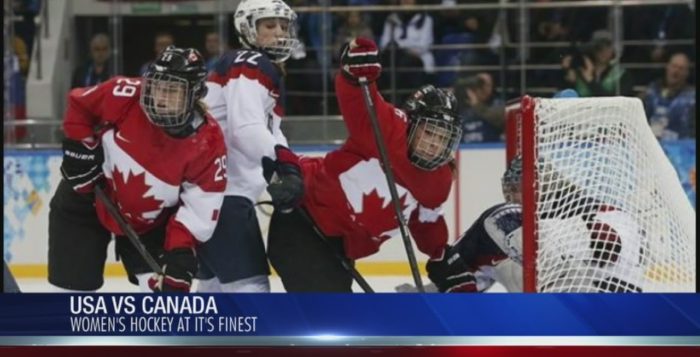This Day in Hockey History – March 19, 1990 – Women Take on the World
Eight years before women’s ice hockey became an Olympic sport, in 1990 the International Ice Hockey Federation (IIHF) sanctioned its first Women’s World Hockey Championship. The tournament, held at Ottawa, began March 19, 1990 and ended a week later on March 25. The first female world champion was the home team, Canada. Their main rivals (to this day), Team USA, took silver, and Finland finished with bronze.
The foundation for the 1990 tournament was laid in the late 1980s. In 1987, a Women’s World Championship was held at Toronto, but the IIHF did not recognize it as official. Two years later, the 1989 European championship was held in West Germany. Of the ten participating nations, the top five teams qualified to compete at World’s. First-place Finland, second-place Sweden, third-place West Germany, Norway, and Switzerland all qualified but had to cover their own expenses. Meanwhile, the two North American teams and Japan automatically received berths in the eight-team tournament. Individual players had to be over 18 (or 16 with a medical waiver) and be residents and citizens of their team’s nation.
Ottawa hosted this inaugural IIHF women’s international tournament. The tournament naturally attracted international attention, and television broadcasts on TSN and RDS brought in about a million more viewers. Though the initial attendance figures caused concern, the finale drew the largest crowd ever seen at a women’s hockey game. For Team Canada’s first game on Monday, March 19, the Civic Centre hosted an audience of 3,578, with about a third of them there thanks to free promotional tickets. Tournament director Pat Reid worried, “Financially we’re going to be in trouble unless we have a big weekend.” By their final game on March 25, the crowd had reached 8,784, prompting Canadian defenseman Dawn McGuire to exclaim, “This is such a breakthrough for women’s hockey. Who could have believed there would be 9,000 fans here cheering us on?”
Thanks to the increase in numbers, Reid remarked, “We won’t have to talk about pink uniforms anymore to get people out to see women’s hockey.” The Canadian Amateur Hockey Association had outfitted Team Canada in pink sweaters and socks. It caused a “pink craze” in Ottawa, like for pink foods and flowers.
Four games took place on opening day, the “dawn of the women’s world hockey championships.” In Pool A, West Germany and Japan made history by playing in the first official women’s world championship game. Shortly after 1 pm, they saluted each other with raised sticks from the blue lines at Barbara Ann Scott Arena. Only 150 spectators saw West Germany win 4-1. Although they won, German defenseman Sandra Kinze said, “I thought it was not so good. We can play much better. The ice is smaller than we are used to, and we were all a little nervous. We were making history.”
Then Canada crushed Sweden 15-1. Swedish goalie Agneta Nilsson faced 62 shots. “They’re big, they skate very fast and their shots come when you don’t expect them,” she explained. “I thought they’d be less good, thinking we are an easy team to beat.” By comparison, Canadian goalie Cathy Phillips only faced three shots. Her teammate Angela James scored four goals but reminded the public, “Remember, 6,000 girls in Ontario alone play hockey and this team was chosen from across the country. In Sweden, there’s 600 players, all in one league. This tournament is a stepping stone for all the countries.”
In Pool B, the United States easily toppled Switzerland with a 16-3 victory. The Ottawa Citizen reported it looked likely they would see “a Canada-U.S. final on Sunday.” Finally, Finland defeated Norway 10-1.
After three more dates of games, the top two teams from each pool advanced to the semifinals while the rest played consolation rounds. On March 24, Team USA beat Sweden 10-3 and Team Canada squeaked out a 6-5 victory over Finland.
The tournament ended on March 25. That morning at the Civic Centre, Finland took bronze over Sweden with a 6-3 win. The grand finale was indeed a matchup between Canada and the U.S. The latter was inspired by a letter from President George Bush stating, “The American people will be rooting for another Miracle On Ice.” The Americans led 2-0 at the beginning of the first period, but that would be their only scoring. Canada knotted the game before the period ended. Despite another reading of the presidential letter during the period break, the Canadians overtook them and went on to win 5-2.
Canada received the first Women’s World Championship gold medal, leaving the U.S. with silver. These two rivals have been the only teams to win gold. Although the Canadians have one more (10), the Americans won most recently (2019). In 1990, the IIHF also gave out individual awards. They awarded Kelly Dyer of the U.S. (and Northeastern University) as the Best Goalie. Riikka Nieminen of Finland was named the Best Forward. Finally, Canada’s Dawn McGuire received the title Best Defenceman and MVP. She summed up everything about having a women’s world champion by saying, “It’s been a dream for all of us.”
Additional Sources:
- Wayne Scanlan, “Canada Wins Big,” Ottawa Citizen, 20 March 1990, p. C1.
- John MacKinnon, “Women Skating Way Into History,” Ottawa Citizen, 20 March 1990, p. C1.
- Wayne Scanlan, “We win!” Ottawa Citizen, 26 March 1990, p. E1.














